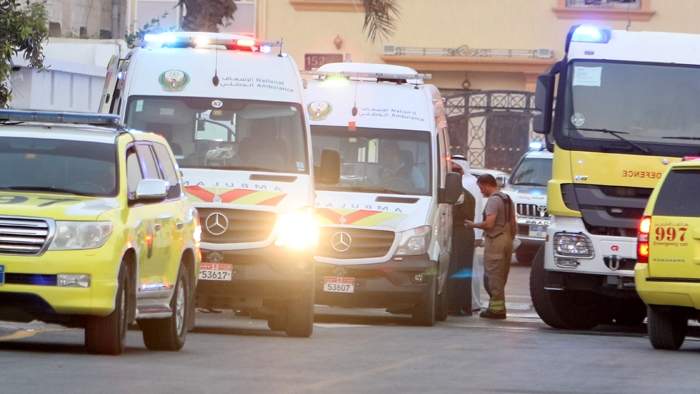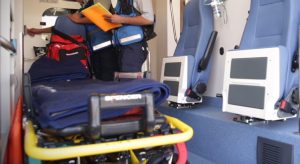
What will be the future of Ambulance service in the Middle East?
What will change in the future of EMS in Middle East regions? Ambulance and emergency services are developing their technologies and guidelines to be more efficient and ready to face any sort of situation. What can we expect by this?
The future of EMS in the Middle East is one of the main topics that has been discussed in the last years. It was also one of the main topics reported during Arab Health 2020. Ahmed Al Hajri, CEO of the National Ambulance of UAE shares his opinion related to the future of EMS in the ME. This will be a quick overview of the EMS system in the Middle East region regarding ambulances, protocols, equipment and education however this ideas need to be adapted and implemented according to the country needs.
The example of the National Ambulance of UAE in the future of the EMS in the Middle East
On the occasion of Arab Health 2020, we wish to know more about this changings and we talked with Ahed Al Najjar, Clinical Education Manager of National Ambulance of UAE, who is now working on education improvements.
Patients transport systems in the future of EMS: which were, and will be the news in the Middle East?
“We have to consider a whole of developments of emergency medical services in the last 15 years. Our experience in the region, not only in the Middle East, started with the need of a type of emergency vehicles and for what purposes (basic, advanced, specialized), then with education and training of the personnel who have to use these vehicles, including the upgrade of the equipment.
The scope of practice has been integrated and there has been also the integration of many systems too, like community health, public health, hospital, trauma centre and other specialized and upgrades in the healthcare system, which are part of the emergency medical system.
 From 2005 to 2010 there were different guidelines for ambulance specification according to the needs, safety and the one who is driving the ambulance and other training specifications needed for a ground ambulance or air ambulance. EVOS started to represents an important step toward ensuring ambulance safety on the roads. In addition to training improvements, technology has been developed that provides ambulance drivers with automatic, audible feedback when they are not driving according to standards.
From 2005 to 2010 there were different guidelines for ambulance specification according to the needs, safety and the one who is driving the ambulance and other training specifications needed for a ground ambulance or air ambulance. EVOS started to represents an important step toward ensuring ambulance safety on the roads. In addition to training improvements, technology has been developed that provides ambulance drivers with automatic, audible feedback when they are not driving according to standards.
By 2011 – in the Middle East and other neighbour countries, EMT level has been modified, updated and started the development of the national EMTs program and Bachelor degree program as paramedics degree. The improvement and the development of the EMS education still move slowly but with a strong impact.
15 years ago we started the EMS service with nurses, due to the needs at that stage most of the oil and gas and remote location companies asked to develop such approach to cover the gap in finding national EMTs / Paramedics, therefore, we start developing a specific program for them to become EMTs, called RN to EMT Transition program so they could operate on ambulances and EMS Operation. From 2007 we started establishing more nurses to work in remote medicine and remote paramedics, but we call them remote Medics/remote Nurse.
In one of the neighbour countries by 2011 things changed and the educational program started becoming 4-year degree program or in other countries 1-year degree program as a diploma (vocational program) therefore the region now on that stage.
Not only the training practice has changed, but also the educational methods of teaching the program by enhancing the learning objectives of each level. In addition, improvement and development include equipment, like remote diagnosis units, visual telemedicine units, ECG monitors, ventilators, and so on. Some years ago we were using very basic ambulance vehicles.
Now we dispose of a mobile ICU vehicle, we have vehicles dedicated to emergency response, Bio-protection Unit, Gynecology and obstetrics, portable Satellite multipurpose Teleclinic, Four Wheel (Quad) Emergency buggy and medical advance team. Personally, we believe that there is still so much more to come because of the technology in high speed in favour of saving life faster and in a shorter time for emergency response. EMS Response of the Future Can Connect New Technology to Save Lives.”
Patient care on the ambulance: how do you see the future of emergency devices like stretchers?
“The global emergency stretchers market is driven by increasing the number of road accidents across the globe. Therefore there is a forward movement in technology as automation in the emergency stretchers. However, there are much scientific evidence and researches came in the EMS in supporting or not supporting for the use of immobilization devices and Ultrasound units in prehospital setup.
However, there still are many pieces of evidence which are not clear in the matter of ambulance devices and there is still more researches needed in a different environment, and so the addressee finds in a situation that is not forced to utilize a specific device, but in case he can. The most important fact is to minimize the complications of the patients on-site.
The future of the ambulance equipment is still wide, especially for us that now are using a wide section of telemedicine protocols of transportation patients and data sharing with the facilities before we arrive. So the exact future of one single device is hard to see, but we can assure that technology will surely improve and will give us new methodologies of work.
There are many technology investments coming like flyboard dual-aviation devices could shorten the response time too. There is some experience in using Medical Evacuation Pod which designed to access inaccessible remote locations, also drone flies in rapidly to secure area including utilizing medical drone rapidly transports an AED and medical care supplies to remote areas. In conclusion, investing in current and future technology can help us save time reaching patients, accomplish important EMS system tasks, present us with a high return on our investment in technology, save money on personnel and in operational areas and, most importantly, save additional lives.”
What about climate change? Do you have to face rescue operation challenges with too hot temperatures and risk of dehydration?
“At the moment, this is not a problem in the region because there are no areas that can be considered so remote unless in an environmental emergency which is rare at the current status. So, the probability that a first responder suffers from dehydration or fatigue is very low. We can apply this more in other regions or countries espouse to multiple wildfires and hurricanes.
National Ambulance is now establishing an Emirati EMT program 3rd batch based on updated teaching methodologies, wireless information technology, flipping classroom, medical simulation to teach effective communication in EMS, integration of the education with other services and techniques which will permit us to enhance what’s taught in the classroom and are great examples of education that can be bridged into practice.
Enhance the critical thinking of our EMT students to be faster in their response. Currently, the National Ambulance response time is within an average of 9 minutes.”
Ambulance dispatch: which are the aims you manage to reach in the Middle East?
“In the US: An estimated 240 million calls are made to 9-1-1 in the U.S. each year. In many areas, 80% or more are from wireless devices. More than 90% of the world’s road-traffic fatalities occur in developing countries, according to the World Health Organization. With the world. In the North, Emiratis-National Ambulance received 115,000 calls per year.
The dispatch is defined by the call for help and then the data are rapidly shared with the assigned ambulance team in response. Sending critical patient information to all members of the team, at the same time, reduces opportunities for communication errors. All departments have the important data they need and can work in parallel, to provide the appropriate care in the most effective way.
Development of technology again can make people’s jobs easier, more efficient and more effective. Every provider in the system of care, from the first responder to hospital, typically has access to multiple mobile devices including utilizing the Voice over Internet Protocol There are still more to come in terms of development, thanks also to the constant improvement of technology.
Emergency dispatch and ambulance response have never been more important. With ageing populations in many countries, increases in chronic disease around the world (and especially in Western nations), economic difficulties in many communities leading to limited or declining resources, increased use of emergency services as primary care by the uninsured, and increasing expectations from the public,154,155 emergency services agencies need strong, evidence-based cases for their practices and a deep foundation of research on which to base decisions. Dispatchers themselves, having finally obtained recognition as public safety and public health professionals will also benefit from participating in research that validates their professional value.”
Are you thinking to help other friendly countries which still have no possibility of building an ambulance service of high-quality like yours?
“In 2006 we started in the Philippines, Indonesia and Nigeria and we are interested to support the friendly countries in the EMS field. There are professionals and laypeople in many countries that are better prepared for emergencies through his efforts. We will sure extend hands to the countries who are most in need of support. For what concerns me, personally I’m helping improving emergency medical services and cardiovascular care education centres in Jakarta, Indonesia.”
READ ALSO
Discover the National Ambulance Service UAE


